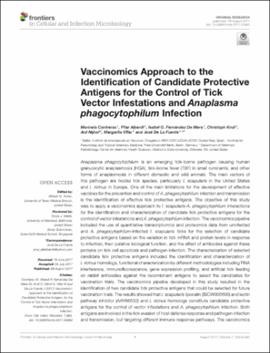| dc.contributor.author | Contreras, Marinela | |
| dc.contributor.author | Alberdi, Pilar | |
| dc.contributor.author | Fernandez de Mera, Isabel G. | |
| dc.contributor.author | Krull, Christoph | |
| dc.contributor.author | Nijhof, Ard | |
| dc.contributor.author | Villar, Margarita | |
| dc.contributor.author | de la Fuente, Jose | |
| dc.date.accessioned | 2019-08-28T16:00:59Z | |
| dc.date.available | 2019-08-28T16:00:59Z | |
| dc.date.issued | 2017-08-09 | |
| dc.identifier | oksd_contreras_vaccinomicsappr_2017 | |
| dc.identifier.citation | Contreras, M., Alberdi, P., Fernandez de Mera, I. G., Krull, C., Nijhof, A., Villar, M., & de la Fuente, J. (2017). Vaccinomics approach to the identification of candidate protective antigens for the control of tick vector infestations and Anaplasma phagocytophilum infection. Frontiers in Cellular and Infection Microbiology, 7, Article 360. https://doi.org/10.3389/fcimb.2017.00360 | |
| dc.identifier.uri | https://hdl.handle.net/11244/321398 | |
| dc.description.abstract | Anaplasma phagocytophilum is an emerging tick-borne pathogen causing human granulocytic anaplasmosis (HGA), tick-borne fever (TBF) in small ruminants, and other forms of anaplasmosis in different domestic and wild animals. The main vectors of this pathogen are Ixodes tick species, particularly I. scapularis in the United States and I. ricinus in Europe. One of the main limitations for the development of effective vaccines for the prevention and control of A. phagocytophilum infection and transmission is the identification of effective tick protective antigens. The objective of this study was to apply a vaccinomics approach to I. scapularis-A. phagocytophilum interactions for the identification and characterization of candidate tick protective antigens for the control of vector infestations and A. phagocytophilum infection. The vaccinomics pipeline included the use of quantitative transcriptomics and proteomics data from uninfected and A. phagocytophilum-infected I. scapularis ticks for the selection of candidate protective antigens based on the variation in tick mRNA and protein levels in response to infection, their putative biological function, and the effect of antibodies against these proteins on tick cell apoptosis and pathogen infection. The characterization of selected candidate tick protective antigens included the identification and characterization of I. ricinus homologs, functional characterization by different methodologies including RNA interference, immunofluorescence, gene expression profiling, and artificial tick feeding on rabbit antibodies against the recombinant antigens to select the candidates for vaccination trials. The vaccinomics pipeline developed in this study resulted in the identification of two candidate tick protective antigens that could be selected for future vaccination trials. The results showed that I. scapularis lipocalin (ISCW005600) and lectin pathway inhibitor (AAY66632) and I. ricinus homologs constitute candidate protective antigens for the control of vector infestations and A. phagocytophilum infection. Both antigens are involved in the tick evasion of host defense response and pathogen infection and transmission, but targeting different immune response pathways. The vaccinomics pipeline proposed here could be used to continue the identification and characterization of candidate tick protective antigens for the development of effective vaccines for the prevention and control of HGA, TBF, and other forms of anaplasmosis caused by A. phagocytophilum. | |
| dc.format | application/pdf | |
| dc.language | en_US | |
| dc.publisher | Frontiers Media | |
| dc.rights | This material has been previously published. In the Oklahoma State University Library's institutional repository this version is made available through the open access principles and the terms of agreement/consent between the author(s) and the publisher. The permission policy on the use, reproduction or distribution of the material falls under fair use for educational, scholarship, and research purposes. Contact Digital Resources and Discovery Services at lib-dls@okstate.edu or 405-744-9161 for further information. | |
| dc.title | Vaccinomics approach to the identification of candidate protective antigens for the control of tick vector infestations and Anaplasma phagocytophilum infection | |
| osu.filename | oksd_contreras_vaccinomicsappr_2017.pdf | |
| dc.description.peerreview | Peer reviewed | |
| dc.identifier.doi | 10.3389/fcimb.2017.00360 | |
| dc.description.department | Veterinary Pathobiology | |
| dc.type.genre | Article | |
| dc.type.material | Text | |
| dc.subject.keywords | anaplasmosis | |
| dc.subject.keywords | immunology | |
| dc.subject.keywords | vaccine | |
| dc.subject.keywords | tick | |
| dc.subject.keywords | ixodes | |
| dc.subject.keywords | anaplasma phagocytophilum | |
